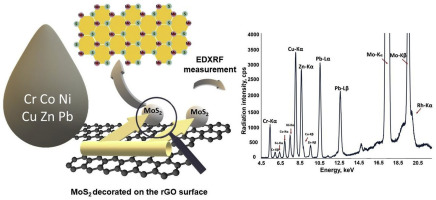当前位置:
X-MOL 学术
›
Spectrochim. Acta B. At. Spectrosc.
›
论文详情
Our official English website, www.x-mol.net, welcomes your feedback! (Note: you will need to create a separate account there.)
Determination of heavy metal ions by energy dispersive X-ray fluorescence spectrometry using reduced graphene oxide decorated with molybdenum disulfide as solid adsorbent
Spectrochimica Acta Part B: Atomic Spectroscopy ( IF 3.3 ) Pub Date : 2020-05-01 , DOI: 10.1016/j.sab.2020.105846 Katarzyna Pytlakowska , Karina Kocot , Barbara Hachuła , Michał Pilch , Roman Wrzalik , Maciej Zubko
Spectrochimica Acta Part B: Atomic Spectroscopy ( IF 3.3 ) Pub Date : 2020-05-01 , DOI: 10.1016/j.sab.2020.105846 Katarzyna Pytlakowska , Karina Kocot , Barbara Hachuła , Michał Pilch , Roman Wrzalik , Maciej Zubko

|
Abstract Reduced graphene oxide (rGO) decorated with molybdenum disulfide (MoS2) was synthesized by hydrothermal method. The physicochemical properties of the nanoadsorbent were characterized by different spectroscopic techniques, namely Fourier transform infrared spectroscopy (FTIR), Raman spectroscopy, X-ray photoelectron spectroscopy (XPS), scanning electron microscopy (SEM), and transmission electron microscopy (TEM). MoS2-rGO was used as a solid nanoadsorbent in a dispersive micro-solid phase extraction (DMSPE) for the preconcentration of heavy metal ions from different types of waters prior to energy dispersive X-ray fluorescence spectrometry (EDXRF) determination. To optimize extraction process parameters such as sample pH, contact time and sample volume, were examined. The determined adsorption capacities for Cr(III), Co(II), Ni(II), Cu(II), Zn(II) and Pb(II) ions were 242, 112, 145, 417, 550 and 498 mg g−1, respectively. Under optimal conditions (pH = 6.5, sample volume 50 mL, and sonication time of 10 min) the calibration curves showed linear response between analytes concentration and intensity of fluorescence radiation in the range 1–200 ng mL−1 for Cr(III), Cu(II), Zn(II) and Pb(II) ions, and 1–100 ng mL−1 for Co(II), Ni(II) ions. The limits of detection were 0.11, 0.12, 0.10, 0.07, 0.08, and 0.09 ng mL−1 for Cr(III), Co(II), Ni(II), Cu(II), Zn(II) and Pb(II), respectively. The precision of the method determined at two concentration levels, e.g. 2 and 20 ng mL−1 varied from 3% for Cu(II) to 5.1% for Co(II) and 1.4 for Cu(II) to 3.6% for Ni(II), respectively. The DMSPE-EDXRF procedure was suitable for determination of target analytes at ultra-trace level even in high salinity samples. The accuracy of the method was proved using certified material NIST 1640a (Trace elements in natural water). The ‘greenness’ of the procedure was calculated with the Analytical Eco-Scale tool.
中文翻译:

以二硫化钼装饰的还原氧化石墨烯为固体吸附剂的能量色散X射线荧光光谱法测定重金属离子
摘要 采用水热法合成了二硫化钼(MoS2)修饰的还原氧化石墨烯(rGO)。纳米吸附剂的理化性质通过不同的光谱技术进行表征,即傅里叶变换红外光谱(FTIR)、拉曼光谱、X 射线光电子能谱(XPS)、扫描电子显微镜(SEM)和透射电子显微镜(TEM)。MoS2-rGO 被用作分散微固相萃取 (DMSPE) 中的固体纳米吸附剂,用于在能量色散 X 射线荧光光谱法 (EDXRF) 测定之前预浓缩来自不同类型水的重金属离子。为了优化提取工艺参数,例如样品 pH 值、接触时间和样品体积,我们进行了检查。对 Cr(III)、Co(II)、Ni(II)、Cu(II)、Zn(II) 和 Pb(II) 离子分别为 242、112、145、417、550 和 498 mg g-1。在最佳条件下(pH = 6.5,样品体积 50 mL,超声处理时间为 10 分钟),校准曲线显示分析物浓度与荧光辐射强度之间的线性响应,范围为 1–200 ng mL-1,对于 Cr(III), Cu(II)、Zn(II) 和 Pb(II) 离子,Co(II)、Ni(II) 离子为 1–100 ng mL-1。Cr(III)、Co(II)、Ni(II)、Cu(II)、Zn(II) 和 Pb(II) 的检测限分别为 0.11、0.12、0.10、0.07、0.08 和 0.09 ng mL-1 ), 分别。该方法在两个浓度水平(例如 2 和 20 ng mL-1)下测定的精密度从 Cu(II) 的 3% 到 Co(II) 的 5.1% 和 Cu(II) 的 1.4 到 Ni(II) 的 3.6% ), 分别。即使在高盐度样品中,DMSPE-EDXRF 程序也适用于测定超痕量水平的目标分析物。使用经认证的材料 NIST 1640a(天然水中的痕量元素)证明了该方法的准确性。该程序的“绿色度”是使用分析生态尺度工具计算的。
更新日期:2020-05-01
中文翻译:

以二硫化钼装饰的还原氧化石墨烯为固体吸附剂的能量色散X射线荧光光谱法测定重金属离子
摘要 采用水热法合成了二硫化钼(MoS2)修饰的还原氧化石墨烯(rGO)。纳米吸附剂的理化性质通过不同的光谱技术进行表征,即傅里叶变换红外光谱(FTIR)、拉曼光谱、X 射线光电子能谱(XPS)、扫描电子显微镜(SEM)和透射电子显微镜(TEM)。MoS2-rGO 被用作分散微固相萃取 (DMSPE) 中的固体纳米吸附剂,用于在能量色散 X 射线荧光光谱法 (EDXRF) 测定之前预浓缩来自不同类型水的重金属离子。为了优化提取工艺参数,例如样品 pH 值、接触时间和样品体积,我们进行了检查。对 Cr(III)、Co(II)、Ni(II)、Cu(II)、Zn(II) 和 Pb(II) 离子分别为 242、112、145、417、550 和 498 mg g-1。在最佳条件下(pH = 6.5,样品体积 50 mL,超声处理时间为 10 分钟),校准曲线显示分析物浓度与荧光辐射强度之间的线性响应,范围为 1–200 ng mL-1,对于 Cr(III), Cu(II)、Zn(II) 和 Pb(II) 离子,Co(II)、Ni(II) 离子为 1–100 ng mL-1。Cr(III)、Co(II)、Ni(II)、Cu(II)、Zn(II) 和 Pb(II) 的检测限分别为 0.11、0.12、0.10、0.07、0.08 和 0.09 ng mL-1 ), 分别。该方法在两个浓度水平(例如 2 和 20 ng mL-1)下测定的精密度从 Cu(II) 的 3% 到 Co(II) 的 5.1% 和 Cu(II) 的 1.4 到 Ni(II) 的 3.6% ), 分别。即使在高盐度样品中,DMSPE-EDXRF 程序也适用于测定超痕量水平的目标分析物。使用经认证的材料 NIST 1640a(天然水中的痕量元素)证明了该方法的准确性。该程序的“绿色度”是使用分析生态尺度工具计算的。


























 京公网安备 11010802027423号
京公网安备 11010802027423号